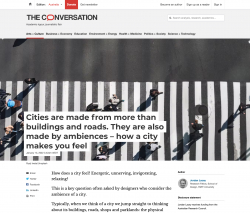‘More of an effect than you can imagine’: Restoring Notre-Dame’s ancient acoustics

Type
News Clipping
Authors
Schwartz ( Madeleine Schwartz )
Category
Article
[ Browse Items ]
Publication Year
2023
Publisher
Sydney Morning Herald, Australia
URL
[ private ]
Tags
Abstract
Four years after a devastating fire tore through the famed Paris cathedral, the quest is on to rediscover the sounds of its past.
When I visited Notre-Dame in the spring of 2021, the whole space seemed to be ringing. The sounds were coming not from the cathedral’s chorus or its organs but from the workers rushing to repair the building, much of which was destroyed by a fire in April 2019. Everywhere were scaffolds, fences, white sheets. I struggled to remember what the building once looked like. My eye was drawn up toward the vaults. In the nave were three holes, where the spire fell.
Much of the cathedral’s restoration, projected to be completed in 2024, will address these large holes. They affect not just the structure of the building but also something that cannot be seen: the acoustics. “Notre-Dame has lost about 20 per cent of its acoustics,” says Mylène Pardoen, who is co-director of the acoustics team working on Notre-Dame – under the aegis of the French Ministry of Culture and the Centre National de la Recherche Scientifique (CNRS), a research organisation from whose ranks specialists have been drawn for the restoration. The holes caused a measurable decline in the glorious resonances that gave the building its unique sound. Of Notre-Dame, Victor Hugo once wrote that its sounds were “fraught with such benediction and such majesty, that they soothed this ailing soul”.
Every space has its own sonic fingerprint. Sit up and say something out loud. If you’re sitting in a room, the sound will bounce off a bookshelf and scatter – or off a plaster wall, and its return will be clearer. In a larger space, the sound might linger. Your voice, your pitch and your words might be the same, but what you hear will be different. When you listen to a performance or a speech, what you hear isn’t just the voice, researchers will tell you. It’s the space.
Historical preservationists have become more attuned to the importance of sound, recognising that we have never experienced the world only through our eyes. Sounds that may be unusual to us once marked time and habits for our ancestors; they can bring us closer to the past, rendering history immediately, sensorially present.
Preservationists note that many major monuments, for all their visual splendour, were built to please our ears. “The experience of the space of worship brought together all the senses, sight and hearing,” says Bissera Pentcheva, an art historian at Stanford University who, with Jonathan Abel, has studied the sound of the Hagia Sophia in Istanbul. “But so much of art history has not been interested in the acoustics.”
In recent years, technological advances have made it easier to objectively capture a building’s acoustics. Brian Katz, who was based in New York working as an acoustic consultant for buildings, now works as a researcher in Paris and runs the Notre-Dame acoustics group with Pardoen. Katz had an important asset for approaching the restoration of Notre-Dame: the only detailed acoustic measurements of the inside of the cathedral, made in 2015. “It was not meant to be used in such an important kind of study,” he says. But it did offer a way to test if it was possible to simulate the cathedral’s sonic qualities...
When I visited Notre-Dame in the spring of 2021, the whole space seemed to be ringing. The sounds were coming not from the cathedral’s chorus or its organs but from the workers rushing to repair the building, much of which was destroyed by a fire in April 2019. Everywhere were scaffolds, fences, white sheets. I struggled to remember what the building once looked like. My eye was drawn up toward the vaults. In the nave were three holes, where the spire fell.
Much of the cathedral’s restoration, projected to be completed in 2024, will address these large holes. They affect not just the structure of the building but also something that cannot be seen: the acoustics. “Notre-Dame has lost about 20 per cent of its acoustics,” says Mylène Pardoen, who is co-director of the acoustics team working on Notre-Dame – under the aegis of the French Ministry of Culture and the Centre National de la Recherche Scientifique (CNRS), a research organisation from whose ranks specialists have been drawn for the restoration. The holes caused a measurable decline in the glorious resonances that gave the building its unique sound. Of Notre-Dame, Victor Hugo once wrote that its sounds were “fraught with such benediction and such majesty, that they soothed this ailing soul”.
Every space has its own sonic fingerprint. Sit up and say something out loud. If you’re sitting in a room, the sound will bounce off a bookshelf and scatter – or off a plaster wall, and its return will be clearer. In a larger space, the sound might linger. Your voice, your pitch and your words might be the same, but what you hear will be different. When you listen to a performance or a speech, what you hear isn’t just the voice, researchers will tell you. It’s the space.
Historical preservationists have become more attuned to the importance of sound, recognising that we have never experienced the world only through our eyes. Sounds that may be unusual to us once marked time and habits for our ancestors; they can bring us closer to the past, rendering history immediately, sensorially present.
Preservationists note that many major monuments, for all their visual splendour, were built to please our ears. “The experience of the space of worship brought together all the senses, sight and hearing,” says Bissera Pentcheva, an art historian at Stanford University who, with Jonathan Abel, has studied the sound of the Hagia Sophia in Istanbul. “But so much of art history has not been interested in the acoustics.”
In recent years, technological advances have made it easier to objectively capture a building’s acoustics. Brian Katz, who was based in New York working as an acoustic consultant for buildings, now works as a researcher in Paris and runs the Notre-Dame acoustics group with Pardoen. Katz had an important asset for approaching the restoration of Notre-Dame: the only detailed acoustic measurements of the inside of the cathedral, made in 2015. “It was not meant to be used in such an important kind of study,” he says. But it did offer a way to test if it was possible to simulate the cathedral’s sonic qualities...
Description
https://www.smh.com.au/national/more-of-an-effect-than-you-can-imagine-restoring-notre-dame-s-ancient-acoustics-20230223-p5cn3d.html
Number of Copies
1
| Library | Accession No | Call No | Copy No | Edition | Location | Availability |
|---|---|---|---|---|---|---|
| Main | 704 | 1 | Yes |


